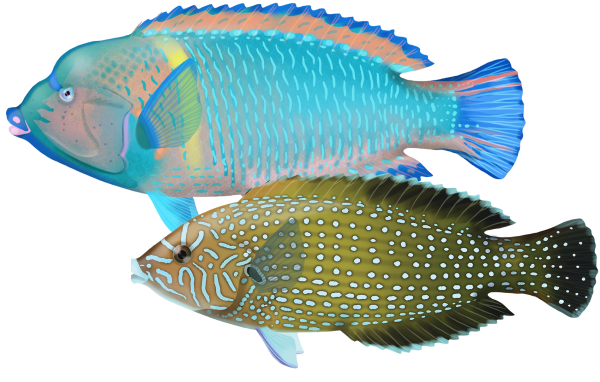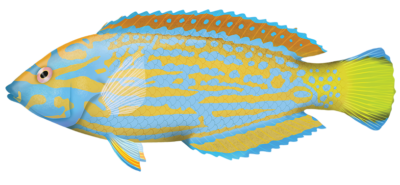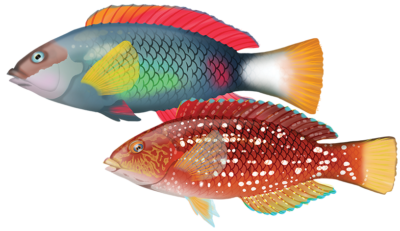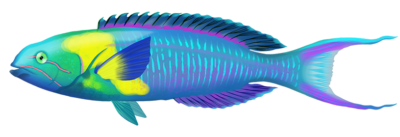Quick Facts
Distribution

Interesting Info
- Diamond Wrasse primarily inhabit the waters around the Great Barrier Reef, but can also be found in other reef systems of Australia, such as in the Coral Sea, Torres Strait, and different reefs of Western Australia.
- They have a slender body shape with a pointed snout and elongated dorsal and anal fins. Males and females exhibiting different coloration and patterns. Males have a vibrant blue coloration on their bodies, while females have a yellowish-green colour with dark markings. Both have diamond-shaped patterns on their bodies, hence the their name.
- Diamond Wrasse are carnivorous, feeding on a variety of small invertebrates. They have a specialised jaw structure that allows them to feed on hard-shelled prey like snails and crabs. They use their protruding canine teeth to crush the shells and access the soft body parts inside.
- They are known to exhibit both solitary and social behaviour. They can be found either in small groups or as solitary individuals, depending on factors such as food availability, breeding status, and territory size.
- These wrasses are known for their vibrant courtship displays. During the breeding season, which typically occurs between spring and early summer, males exhibit intricate colour changes and perform acrobatic displays to attract females.
- The species is known to be a protogynous hermaphrodite, meaning that they can change their sex during their lifetime. Initially, all individuals start as females and can later transition into males.
- These wrasses have a remarkable ability to regrow damaged or lost scales, making them resilient to minor injuries and ensuring their overall health and survival.
- They are a long lived wrasse with an estimated lifespan up to 15 years.
Species Interaction
Recreational Fishing, Aquarium, Snorkeling & Diving
Diamond Wrasse are not targeted for recreational fishing, they may be incidentally caught by anglers targeting other species. They are often a catch and release species in Australia. As an aquarium fish, they are highly prized for their stunning coloration and active swimming behaviour. Their incredible colours and active swimming also makes them a popular fish to seek out for snorkelers and divers.
Scientific Classification
Kingdom: Animalia
Phylum: Chordata
Class: Actinopterygii
Order: Perciformes
Family: Labridae
Genus: Anampses
Species: Anampses Caeruleopunctatus
Conservation Status
In terms of conservation status in Australia, the Diamond Wrasse is not currently listed as a threatened or protected species. However, it is important to ensure the sustainability of their habitats and minimise impacts from human activities such as overfishing or coral degradation.
Fish Taste Quality
Diamond Wrasse are a edible fish, however it is not widely consumed in Australia. It is often described as being similar to other reef fish species.
Taste Rating: 2/5
How to catch
Diamond Wrasse
Catch Difficulty: Intermediate
Tackle: Running Sinker Rig
Bait: Crab, Fresh cut flesh baits, Pilchards, Prawns, Shellfish, Squid, Worms
Technique: Keep bait close to the reef/structure
Popularity: Not targeted - Bycatch
Diamond Wrasse
As Aquarium Fish
Care Level: Moderate
Temperament: Peaceful
Diet: Carnivore
Reef Compatible: Yes
Minimum Tank Size: 100 gallons
Recreational Viewing
- Snorkeling & Scuba
Finding: Easy
Temperament: Peaceful
Location: Inner Reef, Outer Reef, Lagoon
Danger: None





